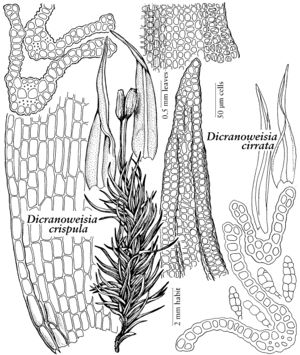Difference between revisions of "Dicranoweisia cirrata"
in C. Milde, Bryol. Siles., 49. 1869,.
Basionym: Weissia cirrata Hedwig Sp. Musc. Frond., 69. 1801
Treatment appears in FNA Volume 27. Treatment on page 396.
FNA>Volume Importer |
imported>Volume Importer |
||
| (6 intermediate revisions by 2 users not shown) | |||
| Line 1: | Line 1: | ||
{{Treatment/ID | {{Treatment/ID | ||
|accepted_name=Dicranoweisia cirrata | |accepted_name=Dicranoweisia cirrata | ||
| − | |accepted_authority=(Hedwig) Lindberg | + | |accepted_authority=(Hedwig) Lindberg |
|publications={{Treatment/Publication | |publications={{Treatment/Publication | ||
|title=in C. Milde, Bryol. Siles., | |title=in C. Milde, Bryol. Siles., | ||
|place=49. 1869, | |place=49. 1869, | ||
}} | }} | ||
| − | |basionyms={{Treatment/ID/ | + | |basionyms={{Treatment/ID/Basionym |
|name=Weissia cirrata | |name=Weissia cirrata | ||
|authority=Hedwig | |authority=Hedwig | ||
| + | |rank=species | ||
| + | |publication_title=Sp. Musc. Frond., | ||
| + | |publication_place=69. 1801 | ||
}} | }} | ||
|synonyms= | |synonyms= | ||
| Line 33: | Line 36: | ||
-->{{#Taxon: | -->{{#Taxon: | ||
name=Dicranoweisia cirrata | name=Dicranoweisia cirrata | ||
| − | + | |authority=(Hedwig) Lindberg | |
| − | |authority=(Hedwig) Lindberg | ||
|rank=species | |rank=species | ||
|parent rank=genus | |parent rank=genus | ||
| Line 48: | Line 50: | ||
|publication year= | |publication year= | ||
|special status= | |special status= | ||
| − | |source xml=https:// | + | |source xml=https://bitbucket.org/aafc-mbb/fna-data-curation/src/2e0870ddd59836b60bcf96646a41e87ea5a5943a/coarse_grained_fna_xml/V27/V27_564.xml |
|genus=Dicranoweisia | |genus=Dicranoweisia | ||
|species=Dicranoweisia cirrata | |species=Dicranoweisia cirrata | ||
Latest revision as of 21:27, 5 November 2020
Leaves crisped and incurved when dry, margins plane to narrowly incurved or recurved at middle, 1-stratose except on margins in distal half, cells smooth; alar cells undifferentiated. Specialized asexual reproduction frequent, multicellular gemmae frequent on abaxial surface of leaves. Capsule with annulus of 1–3 rows of somewhat separating cells; peristome smooth basally, papillose distally.
Phenology: Capsules mature late fall–winter.
Habitat: Forming short turf or tufts on tree trunks and decorticated logs, rarely in rock crevices
Elevation: 1-1900 m
Distribution
B.C., Alaska, Ariz., Calif., Idaho, Mont., Oreg., Wash., Asia, n Africa.
Discussion
Selected References
None.
Lower Taxa
None.
